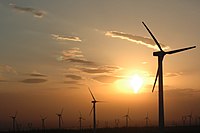
Photo from wikipedia
Much has been made of the potential for wind and solar generation to supply cheap, low-emissions electricity, but considerable disagreement exists as to which combinations of many potential drivers will… Click to show full abstract
Much has been made of the potential for wind and solar generation to supply cheap, low-emissions electricity, but considerable disagreement exists as to which combinations of many potential drivers will enable deep penetration of these technologies. Most existing analyses consider limited factors in isolation, such as investment costs or energy storage, and do not provide rigorous support for understanding which combinations of factors could underpin a leading role for wind and solar. This study addresses this gap by undertaking a systematic sensitivity analysis using a state-of-the-art energy-economic model to comprehensively evaluate the relative magnitudes of five key drivers that may influence future wind and solar deployment in the United States. We find future wind and solar capital costs and carbon policy are the dominant factors, causing the average wind and solar share to vary by 38 and 31 percentage points, respectively. Transmission and storage availability have much smaller effects, causing the average share to vary by no more than 15 and 5 percentage points, respectively. No single factor unilaterally determines wind and solar deployment. The variable renewable share of electricity generation never reaches 100% nationally in any scenario even with low-cost storage, as decreasing marginal returns at higher deployments eventually outpace cost reductions. Average wind and solar shares and ranges of possible outcomes are higher in this study relative to recent multi-model comparison studies due to lower renewable costs and the potential for more stringent policies. Understanding drivers and barriers to renewable deployment has important ramifications for technology developers, infrastructure, market design, and policymakers, and this research provides insights as to which combinations of drivers lead to the greatest share of economic wind and solar deployment and why.
Journal Title: Environmental Research Letters
Year Published: 2019
Link to full text (if available)
Share on Social Media: Sign Up to like & get
recommendations!